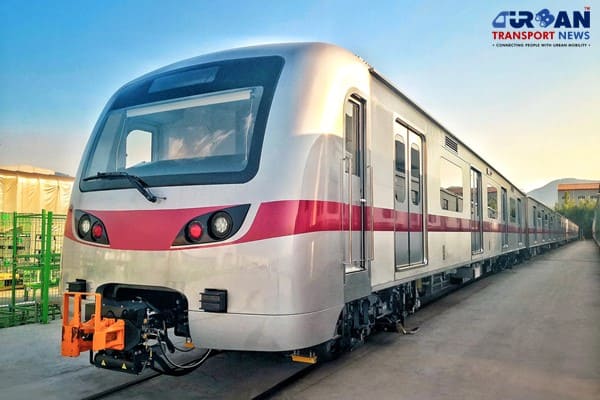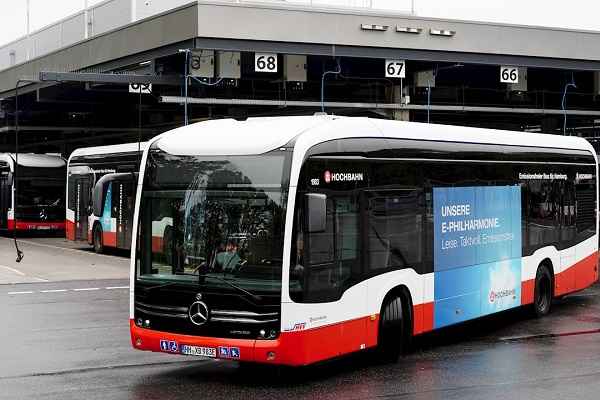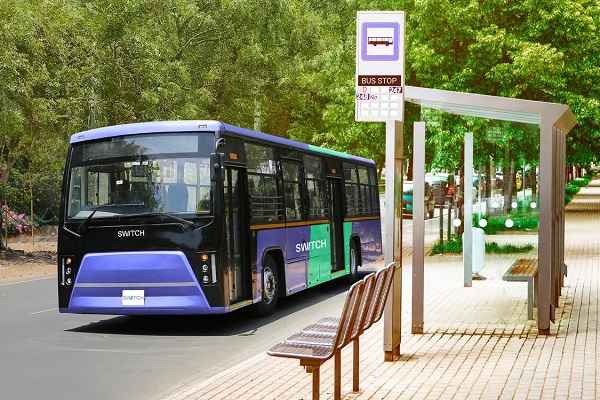 How Weigh-in-Motion Systems Are Revolutionizing Freight Safety
How Weigh-in-Motion Systems Are Revolutionizing Freight Safety Women Powering India’s Electric Mobility Revolution
Women Powering India’s Electric Mobility Revolution Rail Chamber Launched to Strengthen India’s Global Railway Leadership
Rail Chamber Launched to Strengthen India’s Global Railway Leadership Wage and Hour Enforcement Under the Massachusetts Wage Act and Connecticut Labor Standards
Wage and Hour Enforcement Under the Massachusetts Wage Act and Connecticut Labor Standards MRT‑7: Manila’s Northern Metro Lifeline on the Horizon
MRT‑7: Manila’s Northern Metro Lifeline on the Horizon Delhi unveils ambitious Urban Mobility Vision: Luxury Metro Coaches, New Tunnels and Pod Taxi
Delhi unveils ambitious Urban Mobility Vision: Luxury Metro Coaches, New Tunnels and Pod Taxi Qatar approves Saudi Rail Link Agreement, Accelerating Gulf Railway Vision 2030
Qatar approves Saudi Rail Link Agreement, Accelerating Gulf Railway Vision 2030 UP Govt plans to introduce Water Metro services in Ayodhya, Varanasi & Prayagraj
UP Govt plans to introduce Water Metro services in Ayodhya, Varanasi & Prayagraj India’s First Urban Ropeway begins Trial Run in Varanasi, Set to carry 1 Lakh passengers daily
India’s First Urban Ropeway begins Trial Run in Varanasi, Set to carry 1 Lakh passengers daily India and Bhutan to Build First-Ever Rail Link: ₹4,033 Cr Project to Boost Regional Connectivity
India and Bhutan to Build First-Ever Rail Link: ₹4,033 Cr Project to Boost Regional Connectivity
Optimizing Public Transport Asset Performance through Predictive Maintenance

In the present era, Public transportation plays a vital role in providing access to work, education, and healthcare. It also contributes significantly to the efforts against climate change by offering a viable and sustainable alternative to private vehicles. However, in order to fully harness the socio-environmental advantages of public transport networks, it is crucial for operators to enhance passengers' trust by ensuring timely and reliable transportation services. To achieve a seamless experience, it is essential to focus on a critical aspect of public transport: the vehicles themselves.
Digitalization has significantly impacted the maintenance of public transport assets. The integration of smart systems, often powered by artificial intelligence (AI), enables predictive capabilities for anticipating breakdowns and timely renewals of transport resources. This progress leads us towards the realization of zero failure public transport systems, where disruptions and failures are minimized through advanced predictive technologies.
Traditionally, public transport resource maintenance involved inspecting and safeguarding devices and equipment used in transportation. Maintenance intervals were determined based on observations and established best practices. However, resources would often be replaced prematurely to prevent potential failures and mitigate associated costs. Assets encompass various tools and public transport systems, such as ticket machines, buses, trams, and rail tracks.
Implementing predictive maintenance for assets serves as a crucial step towards achieving a zero failure transport system. Imagine streets without 'out of order' buses and reliable ticket machines during your daily commute. These systems offer numerous benefits, including reduced downtime and costs due to continuous monitoring of equipment condition by intelligent systems.
Predictive Maintenance is need of the hour for Public Transport
Public transport maintenance faces numerous challenges that impact the efficiency, reliability, and safety of the transportation system. These challenges include aging infrastructure, funding constraints, limited maintenance capacity, reactive maintenance practices, the absence of real-time monitoring and diagnostic systems, regulatory compliance, and the integration of new technologies. Together, these factors create complexities in maintaining public transport systems. The primary goal of the leading predictive fleet maintenance solution is to prevent unexpected downtime and reduce maintenance costs. It stands out in the market by leveraging Artificial Intelligence to accurately anticipate faults in critical components. The key features of this solution encompass Predictive Maintenance, Remote Diagnostics, and Automated Maintenance Plans.
In order to attract a larger user base, transportation provider must ensure a dependable service that operates smoothly, with buses that remain in service instead of being side-lined for repairs.
Public Transport Challenges in Maintenance
Efficient and uninterrupted operation of bus fleets relies on on-going maintenance and repairs to address wear and tear. Unexpected breakdowns can disrupt services and cause delays, making proactive maintenance crucial. Service teams work diligently behind the scenes to plan and execute maintenance strategies, aiming to enhance the reliability of transport services by minimizing downtime and preventing failures. However, striking a balance between reliability, safety, and cost-effectiveness poses a critical challenge, with each transport operator approaching it differently. It is important to note that not all maintenance approaches are created equal, as some provide better visibility into potential faults and offer improved opportunities to effectively and efficiently prevent breakdowns. The key challenges in Public Transport Maintenance are predictive maintenance, remote diagnostics, and automated maintenance, which are discussed in detail below:
1. Predictive Maintenance:
Implementing predictive maintenance in public transport systems presents various challenges, including issues with data availability and quality, integration of legacy systems, scalability, maintenance resource allocation, real-time decision-making, cost considerations, and change management. Overcoming these hurdles requires a blend of technological solutions, organizational preparedness, and strategic planning. Public transport operators must invest in suitable sensor technologies, data analytics platforms, and predictive maintenance software while considering their specific operational requirements and limitations. Collaboration with technology providers, industry experts, and stakeholders is also crucial for surmounting these obstacles and successfully implementing predictive maintenance in public transport.
2. Remote Diagnostics:
Implementing remote diagnostics of vehicles in public transport systems presents various challenges, including connectivity and communication, data transmission and security, standardization and compatibility, diagnostic accuracy and reliability, human resource and training, cost considerations, and regulatory and privacy compliance. Overcoming these hurdles requires a comprehensive approach that integrates technological solutions, operational adjustments, and collaboration among stakeholders. Public transport operators must thoroughly assess remote diagnostics systems, choosing dependable and compatible solutions, while establishing resilient communication networks. Collaborating with technology providers, vehicle manufacturers, and industry experts is instrumental in surmounting these challenges and facilitating the successful implementation of remote diagnostics in public transport systems.
3. Automated Maintenance:
Implementing automated maintenance in public transport systems presents several challenges, including technology integration, safety and reliability concerns, adaptation of maintenance workflows, cost considerations, managing maintenance complexity, and ensuring legal and regulatory compliance. Overcoming these challenges necessitates meticulous planning, collaboration with technology providers, and close coordination between maintenance teams, IT departments, and management. Pilot projects, thorough testing, and gradual implementation can mitigate risks and facilitate the successful integration of automated maintenance processes in public transport systems.
Deployment of Predictive Maintenance
In a predictive maintenance solution designed for public transport, various vehicle performance metrics are continuously monitored. These metrics include speed, fuel consumption, component temperatures, wear, and engine performance. Additionally, an essential aspect that predictive maintenance solutions must track is the feedback on alerts and reported malfunctions. This creates a continuous information loop between the predictive maintenance provider and the customer, enabling bidirectional information flow. This seamless exchange of information is crucial for the effective functioning of AI as it allows for adjustments and continuous improvement over time. Implementing predictive maintenance is a crucial aspect of a multifaceted business and corporate transformation process. As the future unfolds, predictive maintenance will be integrated alongside more traditional maintenance approaches in public transport companies. These companies must make a strategic decision to adopt a predictive maintenance model and follow the necessary steps.
- Establish a clear vision that outlines the desired outcomes and purpose of implementing condition-based maintenance (CBM), including return on investment (ROI) goals.
- Foster a cultural change within the organization, cultivating an environment that is receptive to new technologies and digitalization.
- Communicate the advantages of predictive maintenance to the maintenance staff and involve them in a collaborative manner from the early stages.
- Select specific asset classes and types to initiate pilot projects, focusing on achieving quick wins and gradually building confidence through small-scale endeavour’s while keeping the long-term vision in mind.
- Procure new assets equipped with sensors or retrofit existing assets with sensing technologies, considering the remaining life of the asset and evaluating retrofit costs against potential ROI.
- Invest in the necessary infrastructure for data hubs, back-office operations, and big data analysis capabilities, encompassing hardware, software, and skilled personnel.
- Alternatively, establish contractual partnerships with service providers that specialize in the aforementioned tasks.
- Adjust the organization and structure of maintenance departments based on lessons learned, learning curves, and adapt or replace staff as required. Review and update internal maintenance strategies, regimes, standards, and procedures accordingly.
- Foster collaborative relationships among stakeholders, including asset owners, operators, maintainers, passengers, and safety agencies, to maximize the benefits of the new maintenance system.
- Continuously evaluate and refine the predictive maintenance approach, incorporating feedback and improvements from all stakeholders to ensure on-going success and optimization.
By following the above steps, public transport companies can effectively embrace predictive maintenance and reap its numerous benefits while navigating the complexities of implementation.
Comprehensive Key features of Public Transport Predictive Maintenance Software Solution
1. Predictive Maintenance: Eliminate unplanned downtime and reduce maintenance costs with the only solution in the market using Artificial Intelligence to predict faults in key components.
- Monitor wear and tear
- Avoid breakdowns
- Future proof
By leveraging these advanced capabilities, the predictive fleet maintenance solution provides a comprehensive frame work for optimizing asset performance, reducing maintenance expenses, and ensuring the smooth and uninterrupted operation of the fleet.
2. Remote Diagnostics:
Remote Diagnostics offers the advantage of having state-of-the-art diagnostic equipment constantly operational in all your vehicles, providing round-the-clock monitoring.
- Fleet Overview
- Vehicle Overview
- Diagnostics Trouble Codes
- Customized alerts
- Metrics
- Sensor readings
- Real-time notifications
By leveraging Remote Diagnostics, you can effectively monitor and analyse your vehicle fleet, detect potential faults or issues early on, and take proactive maintenance actions, resulting in improved reliability, reduced downtime, and optimized vehicle performance.
3. Automated Maintenance Plans:
Automated Maintenance Plans streamline the process of scheduling vehicle maintenance by automatically recording vehicle mileage and operating times. This feature enables you to receive timely alerts when the next service is due. Moreover, these plans can be dynamically adjusted based on faults detected through remote diagnostics and predictive maintenance.
- Create Plans
- Automatic Date Control
- Easy Adjustments
By utilizing Automated Maintenance Plans, you can streamline the maintenance scheduling process, reduce manual effort, and proactively address potential issues. This approach enhances operational efficiency, extends the lifespan of your vehicles, and helps you maintain a well-maintained fleet.
Predictive maintenance enhances the efficiency of detecting issues by minimizing detection time, enabling early intervention, and implementing effective risk mitigation strategies. By identifying potential risks before they materialize, predictive maintenance ensures timely and proactive measures can be taken to mitigate them.
Predictive Maintenance solutions: Data collection method of each component from the vehicle
It is gathered and analyzed using advanced statistical and machine learning algorithms, enabling the identification of patterns and the prediction of potential component failures in advance. Predictive maintenance solutions employ various methods to collect vehicle sensor data, including On-board Diagnostics (OBD) systems, Telematics systems, IoT-enabled devices, and data logs. Here are the different methods used:
- On-board Diagnostics (OBD) systems:Most modern vehicles are equipped with OBD systems that monitor engine performance, transmission, and emissions. Predictive maintenance solutions can access this data through the OBD-II port.
- Telematics systems: Many vehicles now come equipped with telematics systems that provide real-time information on vehicle location, speed, fuel consumption, and other key metrics. Predictive maintenance solutions can access this data through a GPS tracking device installed on the vehicle.
- IoT-enabled devices: Predictive maintenance solutions utilize Internet of Things (IoT) devices, such as sensors and gateways, to collect data from critical vehicle components like the engine and transmission. This data is wirelessly transmitted to the cloud for analysis.
- Data Logs: Predictive maintenance solutions can also collect data logs generated by the vehicle's onboard computer system, including fault codes and performance metrics. This data provides valuable information for proactive maintenance planning and execution.
The collected data is then analysed using advanced statistical and machine learning algorithms to identify patterns and predict potential component failures. The insights gained from this analysis can be used to optimize maintenance schedules, prevent equipment failures, maximize equipment uptime, and reduce maintenance costs.
Typically, a versatile and cost-effective predictive maintenance solution is one that can gather data from various vehicle types rather than being limited to a specific brand or model. This flexibility enables the solution to be applied across a broader range of vehicles without requiring additional hardware purchases or installations. By accommodating diverse vehicles, the solution becomes more adaptable and efficient, providing greater value to users.
Software requirements for Predictive Maintenance and Analytics
When developing software for vehicle predictive maintenance and analytics, there are several key requirements to consider. These requirements ensure that the software meets the needs of the maintenance process and delivers effective functionality. Data storage and analytics play a crucial role in vehicle predictive maintenance. Here are the steps involved in implementing data storage and analytics for effective predictive maintenance in vehicles. They are Data Collection, Data Storage, Data Integration, Data Pre-processing, Data Analytics, Predictive Modelling, Key Process Indicators, Reporting and Visualization, Scalability and Performance, Security and Data Privacy, User-friendly Interface, Decision Support, Maintenance Recommendations, Continuous Improvement. By implementing robust data storage and analytics processes, vehicle predictive maintenance can enable proactive and efficient maintenance strategies, reduce costs, improve reliability, and maximize the lifespan of vehicles.
Benefits of Predictive Maintenance
Predictive maintenance serves as an invaluable tool for enhancing asset management decision-making, offering a range of significant benefits:
- Accelerated identification and timely assessment of asset deterioration, enabling prompt actions to mitigate risks and minimize disruptions.
- Enhanced asset availability and optimized maintainability for operators, ensuring efficient operations and reducing downtime.
- Improved asset reliability and safety, fostering passenger trust and bolstering the operator's reputation for delivering a reliable and secure transportation experience.
- Reduced system life cycle costs through proactive maintenance, preventing major breakdowns and expensive repairs while maximizing the lifespan of assets.
- By leveraging predictive maintenance, public transport operators can make informed decisions, increase asset performance, and ultimately provide a more reliable and cost-effective service to passengers.
Key take aways
When creating software for predictive maintenance, remote diagnostics, and automated planning, it is crucial to take into account various essential features to ensure that the software aligns with the maintenance process requirements and provides efficient functionality. The key features of Remote Diagnostics are detailed below:
- Monitor wear and tear (Condition Monitoring): Monitor the condition of key vehicle components and proactively replace them before they reach a critical state. Stay informed about the wear and tear of components like starter batteries and brake pads, with precise information regarding dates or mileage.
- Avoid Breakdowns (Fault Prediction with Artificial Intelligence): Utilize cutting-edge Artificial Intelligence technology to accurately predict faults in critical components, ensuring the elimination of unplanned downtime and reducing maintenance costs.
- Future proof (Breakdown Prevention): Stay ahead of potential breakdowns by receiving timely reports that highlight early signs of malfunction in major components such as the turbocharger and the engine. This proactive approach enables prompt action to mitigate risks and prevent costly disruptions.
- Fleet Overview: Obtain a comprehensive view of your fleet, allowing you to monitor the Diagnostic Trouble Codes (DTCs) and customized alerts that are active in your vehicles. Assess the severity of these codes to prioritize maintenance actions effectively.
- Vehicle Overview: Access detailed records for each vehicle, providing key data such as mileage, fault codes, and active alerts. This comprehensive overview enables you to have a complete understanding of the vehicle's status and facilitates efficient maintenance planning.
- Diagnostics Trouble Codes: Gain insights into each fault code, including its description, location of occurrence, historical occurrences of similar fault codes, and troubleshooting steps. This information aids in swiftly identifying and resolving issues.
- Customized Alerts: Access the active alerts that you have configured, accompanied by graphical visualization of threshold values. This feature allows you to monitor specific parameters and receive timely notifications when thresholds are exceeded.
- Metrics: Understand key maintenance metrics, such as the range of operating coolant temperatures, enabling you to track the performance and health of your vehicles more effectively.
- Sensor Readings: View and compare the behaviour of various sensors or monitor them in real-time, providing valuable insights into the condition and performance of critical components.
- Real-time Notifications: Receive notifications, such as SMS, email, or web notifications, in real-time for your configured alerts. This ensures that you stay informed promptly about any critical issues or maintenance requirements.
- Create Plans: Effortlessly generate maintenance plans that include recurrent tasks based on either mileage or time. This allows you to establish a systematic approach to maintenance scheduling and ensure that essential tasks are not overlooked.
- Automatic Date Control: Say goodbye to manually checking mileage or time for maintenance purposes. With Automated Maintenance Plans, the system automatically updates and tracks these variables for you. This eliminates the need for manual record-keeping and minimizes the chances of missing critical service intervals.
- Easy Adjustments: Flexibility is crucial when it comes to maintenance planning. With Automated Maintenance Plans, you can easily incorporate additional tasks to replace or repair components based on predictive maintenance alerts and reports. This ensures that your maintenance activities align with the real-time condition of the vehicles, optimizing their performance and reliability.
Conclusion
Predictive maintenance is a significant advancement in achieving a zero failure public transport system by accurately predicting asset conditions and optimizing maintenance schedules. This proactive approach minimizes failures and ensures optimal asset health and performance, leading to improved reliability and efficiency. To embark on this digital transformation, public transport companies should strategically adopt a predictive maintenance model. Clearly defining goals, such as reducing maintenance costs and extending asset lifespan, is crucial for securing investment and support. While challenges may arise, the benefits of predictive maintenance far outweigh the costs. Effective communication about these advantages is vital for successful adoption. By committing to predictive maintenance, companies can optimize operations, enhance asset performance, and achieve improved efficiency and customer satisfaction. Embracing this transformative strategy brings long-term rewards.







